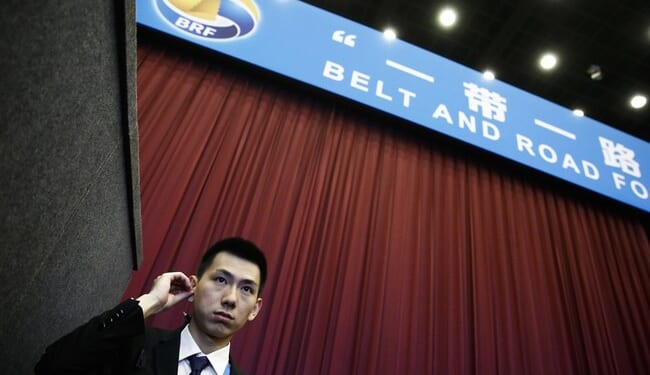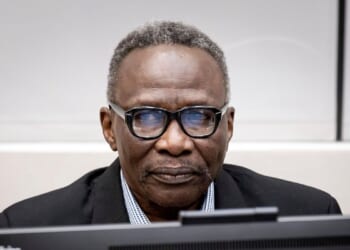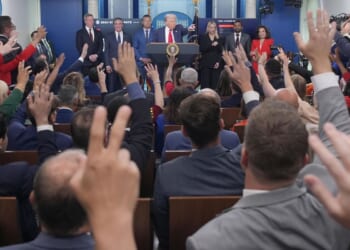
Welcome to the fourth installment of my “Tracking China in the Americas” series, in which I cover some underreported stories on China’s footprint in the Western Hemisphere. I actually had something different planned for this week — a deep dive into how China is reaching out to young people in the Western Hemisphere — but when I saw this bridge fall, I knew I had to switch gears. Anything to point out what China does wrong should spread far and wide. So, check back in next week for the young people stuff. Let’s get to the Hongqi Bridge.
You may have seen it on social media, but a portion of the 2,500-foot Hongqi Bridge in China’s southwestern province of Sichuan collapsed on Tuesday. Thankfully, no one was hurt as law enforcement had closed down that portion of the highway that links Sichuan to Tibet on Monday, “after cracks appeared on nearby slopes and roads, and shifts were seen in the terrain of a mountain.” The bridge was only open for a couple of months.
JUST IN: Hongqi bridge in China collapses just months after opening after shifts in the mountain pic.twitter.com/Ukm6w1uR5K
— Libs of TikTok (@libsoftiktok) November 11, 2025
You may be thinking: This happened in China. What does it have to do with the Western Hemisphere? Well, let’s just say that China’s disastrous projects don’t stay in the homeland.
When I saw the video myself, it made me think of something Marco Rubio said back in March while traveling to several Caribbean countries. He’d been on a road that the Chinese built from Guyana to Suriname and said it was so bad that it nearly gave him a concussion.
“It was terrible,” he said. “They paid these people to build this road, and then they bring their workers. They bring their workers. They don’t hire you. They bring their workers in to do all the work or they want you to borrow a bunch of money, and then they hold it over your head.”
And that’s the problem. China has its heavy Communist hand in infrastructure projects across Latin America and the Caribbean, largely through its Belt and Road Initiative (BRI). It’s invested billions in dams, ports, railways, and highways, often in exchange for access to resources, diplomatic leverage, or debt that strains entire economies. But like Rubio said — and like the falling of that bridge today shows — the work is not necessarily high-quality and is often problematic, if these state-owned companies even bother to finish it. Let’s take a look at some examples that are closer to home. And trust me when I say that these are just a few of many.
Costa Rica’s Route 32 Highway Extension
I’ll start with the China Harbor Engineering Company’s (CHEC) project to expand 107 kilometers of Highway 32 in Costa Rica because I actually spend a lot of time on this particular road. It connects the capital of San Jose to the the lesser-visited Caribbean coast of the country. The drive takes hours, it’s boring, people drive fast, and the road is always under construction to the point that you have to reroute or drive in the wrong lane. And if it rains a lot, forget it. It can shut down for hours, if not days, due to mudslides.
I didn’t actually know until today that China was involved with the construction project that I’ve been subjected to so many times, which started in 2017 and was supposed to be completed in 2020. As far as I know, it remains unfished. So far it’s been dangerous for pedestrians and local wildlife due to unfulfilled crossing construction promises, it’s an economic disaster, it’s had a negative impact on the area’s water supply, and it’s poorly designed overall.
In 2022, Costa Rica’s Public Works and Transportation minister at the time, Luis Amador, pointed out how problematic it was. “You start to dig a little bit and you realize that… there was no international bidding; it was a contract on the basis that the loan was already conditionally,” he said. “It was a very expensive loan for the country, A series of problems began from then on.”
According to Diálogo Américas, “CHEC, a subsidiary of China Communications construction Company (CCCC), which the World Bank blacklisted back in 2009, is known for its poor performance worldwide, yet has many projects in Latin America, about half of which are uncompleted.”
Ecuador’s Coca Codo Sinclair Hydroelectric Dam
This might be the most well-known project on the list. Some even say it’s symbolic of China’s influence in Latin America. The Chinese Sinohydro Corporation built the $3.2 billion Coca Codo Sinclair Dam, which opened in 2016. Not only was it poorly built, but it doesn’t operate the way it’s supposed to.
Here’s more from the Center for Latin America and Latino Studies’ Aula Blog from 2024:
When it was inaugurated by Presidents Rafael Correa and Xi Jinping in 2016, CCS was celebrated as a triumph of South-South cooperation between Ecuador and China, and a contribution to sustainable green growth in Ecuador. Yet nearly eight years after this inauguration, the project has yet to be formally ‘received’ by the Ecuadorian government from the contractor, Chinese state-owned enterprise Sinohydro. The reason for this prolonged state of limbo comes down primarily to fissures present in the powerhouse distributor pipes: despite repeated welding, they have yet to be fully repaired, and a durable fix may not be possible. In addition, the project’s sediment removal mechanisms have proven dysfunctional, leading to frequent pauses in the project’s operation over the past year. Separately, severe regressive erosion on the Coca River is advancing towards the dam and may trigger its collapse. The erosion advanced 1.2 kilometers upriver over the course of three days last month, and is currently located 6 kilometers from the dam.
According to Dialogue Earth, it “largely fails to fulfil its 1,500-megawatt potential” and “in late 2024, as Ecuadorians suffered power cuts of up to 14 hours a day, the plant ran at only one third of its capacity. This year, the risk is latent: a severe drought is forecast, and once again, power cuts are expected.” Structural defects in the hydroelectric plant include “more than 17,000 cracks reportedly detected since operations began, as well as defective valves and poorly installed components.” At one point last year, things got so bad that Ecuador had to bring in electricity from Colombia.
Earlier this year, Ecuadorian President Daniel Noboa visited China and agreed to drop arbitration against the state-owned company due to the faulty construction and performance issue. In exchange, China will pay $400 million in compensation and Ecuador will take over operations.
Venezuela’s Tinaco-Anaco High-Speed Railway:
In 2009, Venezuela and China signed a $7.5 billion deal for a high-speed railway, the Tinaco-Anaco, which would stretch 467 kilometers, or 290-ish miles, from west to east “through the plains – from Cojedes state to Anzoátegui.” The ambitious goal, according to then-president Hugo Chávez, was to create jobs, modernize Venezuela’s infrastructure, encourage development in certain areas, and create South America’s first bullet train. It was all part of his 13,655-kilometer “National Socialist Plan for Railway Development.”
The reality is that only about 31% of the Tinaco-Anaco line was ever built by the Chinese, though, to be fair, only about 40 kilometers of the entire project runs today. But I’d expect nothing less from something called the “National Socialist Plan” of anything.
So, what happened to the Chinese promise? Within a year, work slowed due to bickering over several issues. Venezuelan workers accused the Chinese of ignoring laws, violating contracts, and paying whenever they felt the urge. There were communication issues, as in the state-owned China Railway Engineering Corporation (CREC) tried to tell the Spanish-speaking Venezuelans what to do in Mandarin and didn’t provide a translator. There was also concern that the CREC worked without worry of the damage it was doing to the environment — polluting rivers and causing unnecessary deforestation.
CREC laid off workers, claiming Venezuela wasn’t paying its end of the deal, and imported its own. What part of the railway was completed was deemed shoddy workmanship and included misaligned rails and structures built using substandard materials that would not stand up to the tropical heat and humidity for very long. Venezuela’s economic crisis sealed the deal.
By 2015, China walked away, leaving the project unfinished. Today, “tunnels, rails and thick concrete columns with no obvious purpose stand as monuments to neglect. They look like testimonies left, with an indecipherable meaning, by giants or extraterrestrials,” Locals looted some of it after the Chinese were gone. What was left rusted or became overgrown with weeds. And Venezuela found itself deeper in debt to Beijing.
As I said, there are so many similar stories in Mexico, Argentina, Nicaragua, Colombia, Peru, Jamaica, the Bahamas, etc. that I could touch on, and honestly, every single one of them would make for a great article in itself. That’s actually why I’m publishing this so late in the day, despite wanting to get this column out earlier so Tuesdays to that more people will see it — I got way too involved in my research.
What starts as a flashy project that gets everyone excited often ends with poor workmanship, environmental destruction, corruption, and debt that leaves these nations vulnerable. The collapse of the Hongqi Bridge is a symbol of the type of cost-cutting infrastructure disasters that China exports to our hemisphere.
Even so, it’s still a strategic power grab, and it’s happening in our own backyard, destabilizing our trading partners and allies, empowering our adversaries, and contributing to our own problems, like mass migration and drug trafficking. This is why it’s important for the United States to support democracy and Western values within the Western Hemisphere and build robust, transparent partnerships with willing nations. And that’s why I’m not going to stop writing about it.
Here are the previous weeks’ columns if you missed them:
1. China Is Making a Big Move in Our Own Backyard — but No One Is Talking About It — Just how much land does China control in Nicaragua?
2. Tracking China in the Americas: A New Column on Underreported Influence in Our Hemisphere — China is heavily invested in Bolivia, but the new Bolivian president-elect is 100% pro-U.S.
3. Tracking China in the Americas: When Beijing Controls the Capital’s Power Grid — China controls 100% of Lima, Peru’s electricity.
Help us continue to report the stories the MSM won’t tell you. Become a PJ Media VIP member. Right now, we’re running a Schumer Shutdown Sale. Use promo code POTUS47 to get 74% off your VIP membership. That’s just $12.74 for the entire year. Click here to get started. Hurry! The sale ends when the shut down is over.










